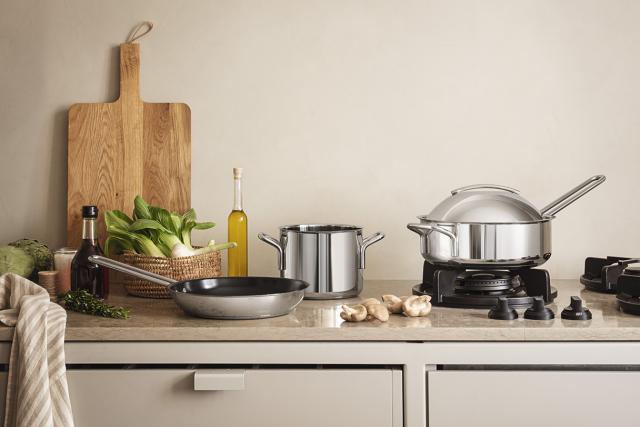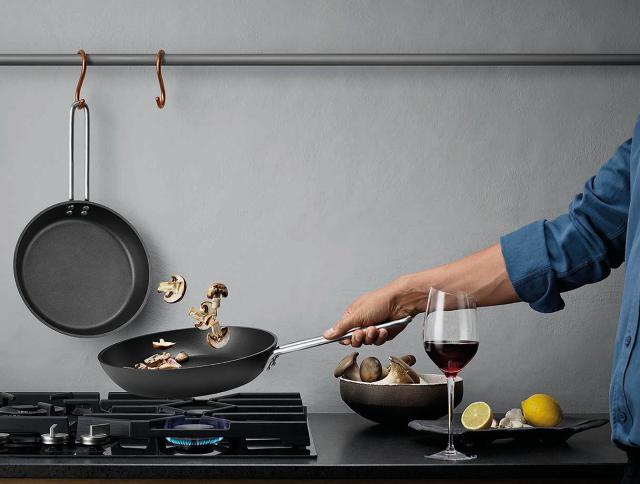.jpg&width=640&format=webp)
What does it take
to become the world’s greatest Chef?
For more than 20 years, Eva Trio has provided pots, pans, and utensils to Danish chefs competing in the world’s toughest cooking competition, Bocuse d’Or. Step into the training kitchen and meet the Danish candidates as they discuss precision, endless repetitions, and the essential tools of the trade.
.jpg&width=640&format=webp)
.jpg&width=640&format=webp)
Tucked away in a quiet corner of the Hotel and Restaurant School in Valby, Copenhagen, lies a compact yet meticulously equipped kitchen. At first glance, it resembles any other professional kitchen: machines lined up, stainless steel surfaces, and slip-resistant floors.
But this is no ordinary kitchen. It’s a training facility, a meticulously designed replica, a precise mirror image of a kitchen in Lyon, France.
On the windowsill stands a golden statuette: a man in a classic chef’s uniform, tall hat, stern expression, and arms crossed. It’s a figure of Paul Bocuse, the legendary French chef whose name and legacy gave birth to Bocuse d’Or—the most prestigious cooking competition in the world, often seen as the unofficial world championship of culinary arts.
Paul Bocuse and his competition are the reason why two young chefs are pushing themselves to their limits in this specially designed kitchen, training up to 100 hours a week. After nearly two years of preparation, they will face their ultimate test in January.
Get the same equipment as Sebastian and Phillip
The same equipment that Sebastian Holberg and Phillip Nilsen will bring to Bocuse d’Or can be found in your own kitchen. Discover Eva Trio’s wide range of pots and pans here.
Sebastian Holberg Svendsgaard, 25, from Vemmelev, is Denmark’s Bocuse d’Or candidate—the youngest ever to represent the country. He has worked in renowned restaurants like Geranium and Babette but has taken time off to focus solely on training. Despite his young age, Sebastian is no stranger to Bocuse, having participated twice as an assistant and winning silver as a commis in 2021.
Standing by his side is 22-year-old Phillip Nilsen from Aarhus, serving as the commis. Philip, who works at TreeTop in Vejle, is competing in Bocuse d’Or for the first time.
Supporting them is a team of coaches, mentors, assistant chefs, coordinators, and sponsors. Each plays a role in what will culminate in one final three-course menu.
I cooked 200-300 eggs a day
“We’re in great shape,” Sebastian Holberg says with a laugh, patting his stomach.
He’s a cheerful, lively guy with both arms covered in tattoos—tomatoes and lemon balm in permanent ink. Watching the large man delicately arrange edible flowers with tweezers is a sight to behold. He looks like someone who could be causing mischief—until he steps into the kitchen. Suddenly, the playful, boyish attitude transforms into deep concentration and measured professionalism.
Bocuse d’Or participants are of a different breed. The competition demands an extraordinary level of attention to even the smallest details. Perfectionism is essential, and this precise work must be done under extreme time pressure.
There is only one way to prepare: repetition, repetition, repetition.
“We practice each element countless times. When we test a garnish, it’s made again and again. We tweak and improve until it’s perfect,” explains Sebastian. He offers an example:
“At my first European Championship, we had to create the world’s best quail egg. I cooked 200-300 eggs a day. We pickled, salted, and smoked them. Tried everything. In the end, we had boiled 5-6,000 quail eggs during training.”
Everything unnecessary is stripped away, leaving behind pure, edible masterpieces. It’s craftsmanship that borders on art—a drive to present the very best of the best.
“It takes both mental and physical endurance. You need to stay focused for hours, be on your feet all day, and constantly push yourself to get better — day after day,” Sebastian says.
.jpg&width=640&format=webp)
Bocuse d’Or
Established and named after French master chef Paul Bocuse, this competition challenges participants to create two dishes in 5 hours and 30 minutes. Traditionally, this includes one plated dish and one platter, but in recent years, the plated dish has become a three-course menu.
The competition sets the main ingredients, while the chefs choose the accompaniments, reflecting their country’s culinary traditions. Judging criteria include taste, presentation, time management, and elements like hygiene, food waste, and kitchen organization. The Bocuse d’Or is held every two years in Lyon, France.
.jpg&width=640&format=webp)
It’s like top-tier competitive sports
A typical day in the training kitchen starts calmly, with coffee and a rundown of the tasks ahead. As the competition draws closer, the days get longer, more intense, and the routines more rigid. Every day is dedicated to specific tasks.
The first day focuses on the setup—every piece of equipment is polished and placed in its exact position. Every detail is planned with lists dictating where each knife, pan, and pot belongs. It’s a process that quickly takes 14-15 hours.
The second day is dedicated to ingredients—vegetables are peeled, herbs picked, and oils prepared. On the third day, time trials begin, where the food must be completed within the competition’s 5-hour, 30-minute limit. After each session, the team conducts a thorough evaluation: what went well and what can be improved? On the fourth day, any errors are corrected, and the cycle starts over.
Two years of experimenting, adjusting, and perfecting, while friends, family, and free time fade into the background. If you aspire to be the world’s best chef, you must be prepared to give up time, freedom, and everything else that doesn’t bring you closer to your goal.
“It doesn’t feel like work. It’s more of a lifestyle,” says Phillip Nilsen, who didn’t hesitate to quit his job and move from Aarhus to Copenhagen when Sebastian offered him a spot on the team. He explains:
“It’s like top-tier competitive sports, where you constantly push yourself to improve. Some days I drive home thinking it’s not good enough. But tomorrow—it will be better. That motivates me.”
Sebastian nods in agreement:
“I want to show my son that you can achieve your goals if you fight for them. That’s a big part of why I’m putting everything into this competition.”
The adrenaline is pumping
At the last three Bocuse d’Or competitions, Danish participants have delivered outstanding results: gold, silver, and gold again. These impressive achievements come with high expectations, and now there’s a pressure to defend Denmark’s top spot in the world of elite gastronomy. No nation has ever won the competition twice in a row.
“To be completely honest, only gold will satisfy me,” says Sebastian Holberg.
The pair has already proven their worth. Earlier this year, they secured first place at the European Bocuse d’Or competition in Trondheim. But the question remains: Can they maintain their level when the Danish training kitchen is swapped for the competition kitchen in Lyon?
Bocuse d’Or is notorious for its intensity. The entire competition is a whirlwind of noise—blaring horns, bells, and cheers echoing from packed stands. Amid the chaos, the judges move through the kitchen—watchful and authoritative, observing every movement. It’s fine dining turned into an extreme sport. Culinary artistry performed in a noisy, bustling sports arena.
“We have five and a half hours to complete everything we’ve trained for. It’s a big budget and a huge responsibility, but it’s also an incredible feeling to finally cook the food you’ve been practicing over and over,” says Sebastian, who has competed in Lyon three times before.
“I can’t compare it to anything else—the adrenaline pumps from the moment you wake up until you go to bed… maybe even for an entire week afterward.”
It has to be top quality
Despite only knowing each other since the start of the training camp, there’s a natural calm and understanding between the two chefs—almost as if they’ve worked together for years. This deep sense of trust extends beyond just the partnership between them; it includes the entire team supporting them. In the kitchen, they barely speak—they don’t need to. They instinctively know when something is about to boil over or when everything is flowing smoothly.
"Sebastian has experience from three-star restaurants, while I have a slightly more down-to-earth approach," says Phillip Nilsen.
"We work differently—he creates elegant, refined dishes, while mine are a bit more rustic. Together, we complement each other perfectly."
While their teamwork is crucial, it’s not enough on its own. Without the right tools, even the best team will fall apart. In the heat of competition, they must trust their equipment just as much as they trust each other.
“When you train as precisely as we do, where every gram and millimeter matters, the equipment is absolutely essential,” Phillip emphasizes, continuing:
“The pots and pans need to be perfect. They must be of the highest quality so they perform consistently every time. That’s the only way we can ensure that the results are the same in both training and competition.”
At the end of January, the verdict will be delivered: Was all the hard work, all the sacrifices, truly worth it? Over the next few months, the pressure will only increase, the training will become even more intense and all-consuming. It’s hard to say if anyone can truly be ready for what lies ahead, but Sebastian Holberg and Phillip Nilsen certainly look prepared.
.jpg&width=640&format=webp)
.jpg&width=640&format=webp)
.jpg&width=640&format=webp)
.jpg&width=640&format=webp)
.jpg&width=640&format=webp)
.jpg&width=640&format=webp)
.jpg&width=640&format=webp)
.jpg&width=640&format=webp)
.jpg&width=640&format=webp)



